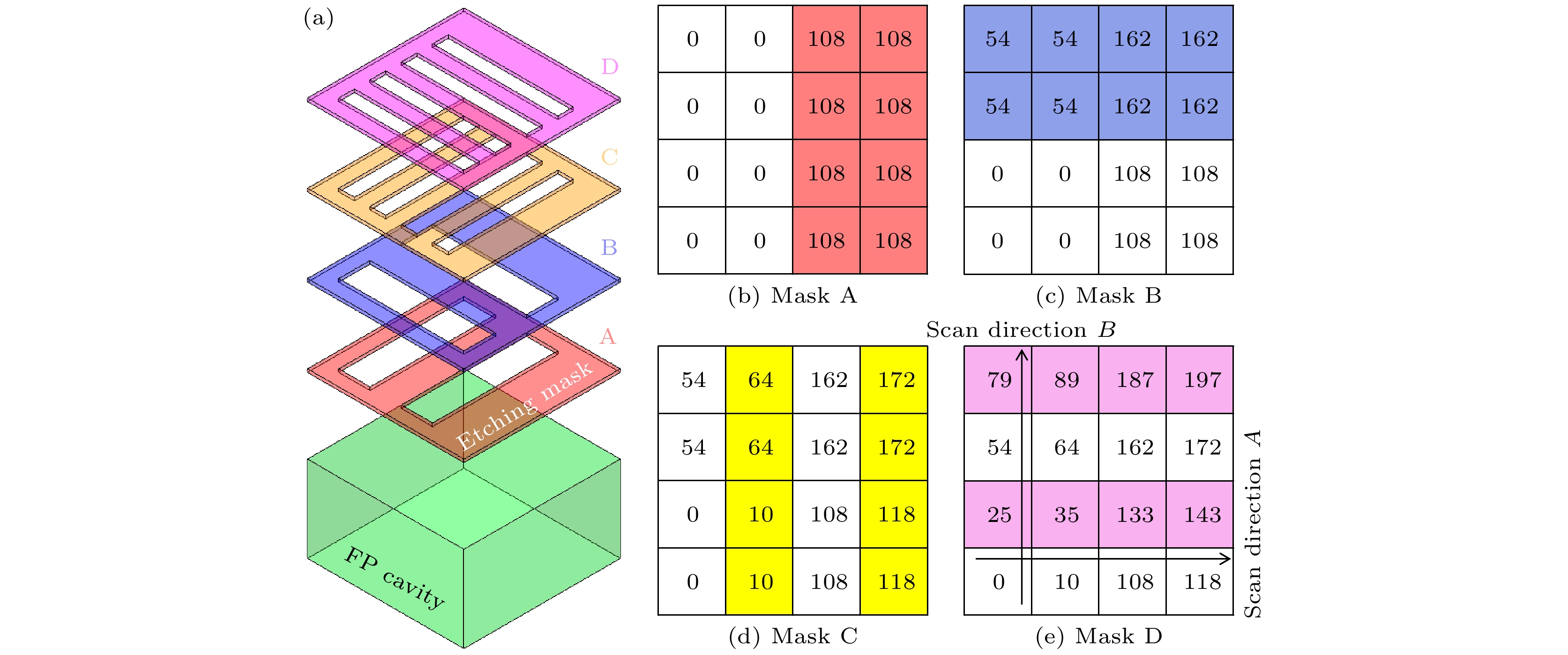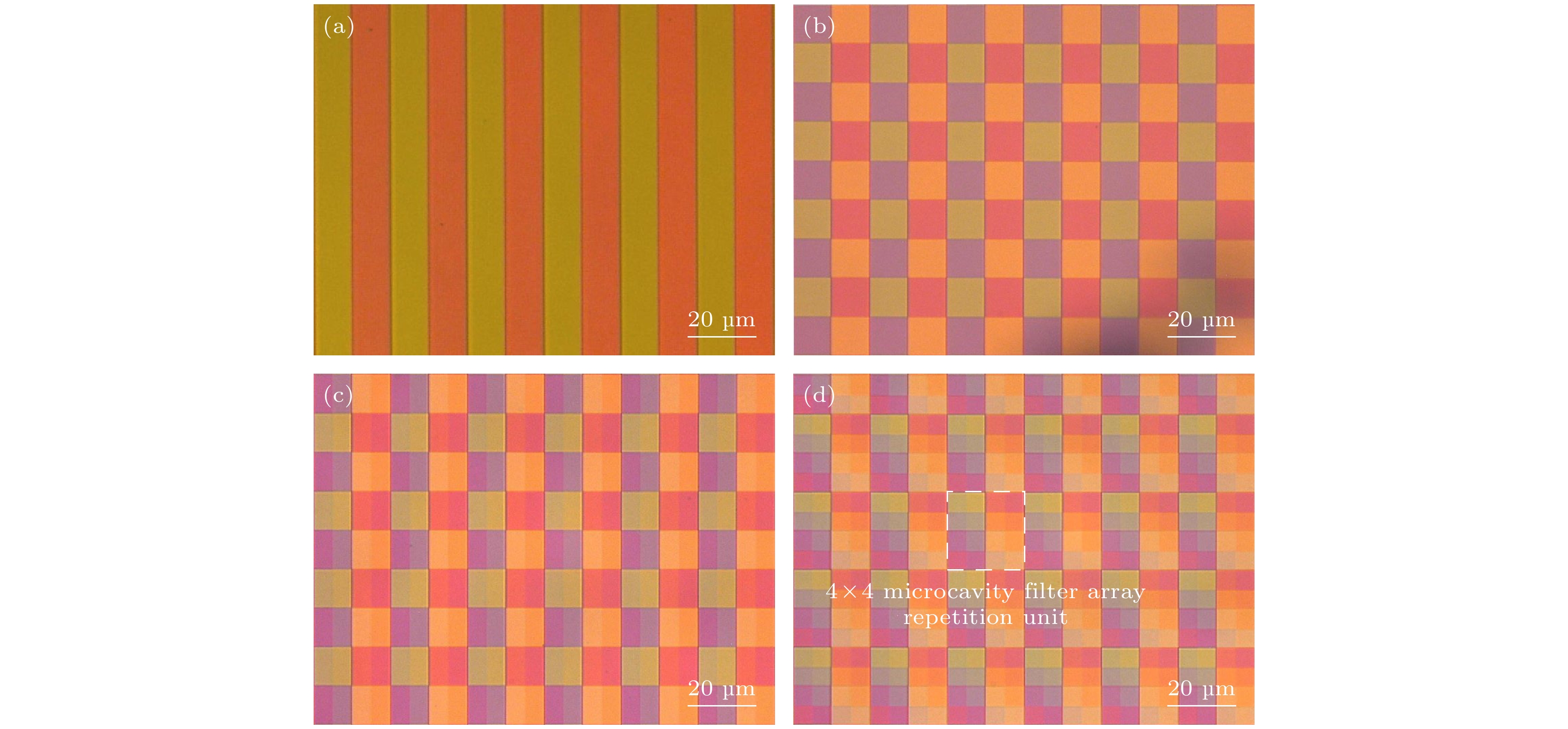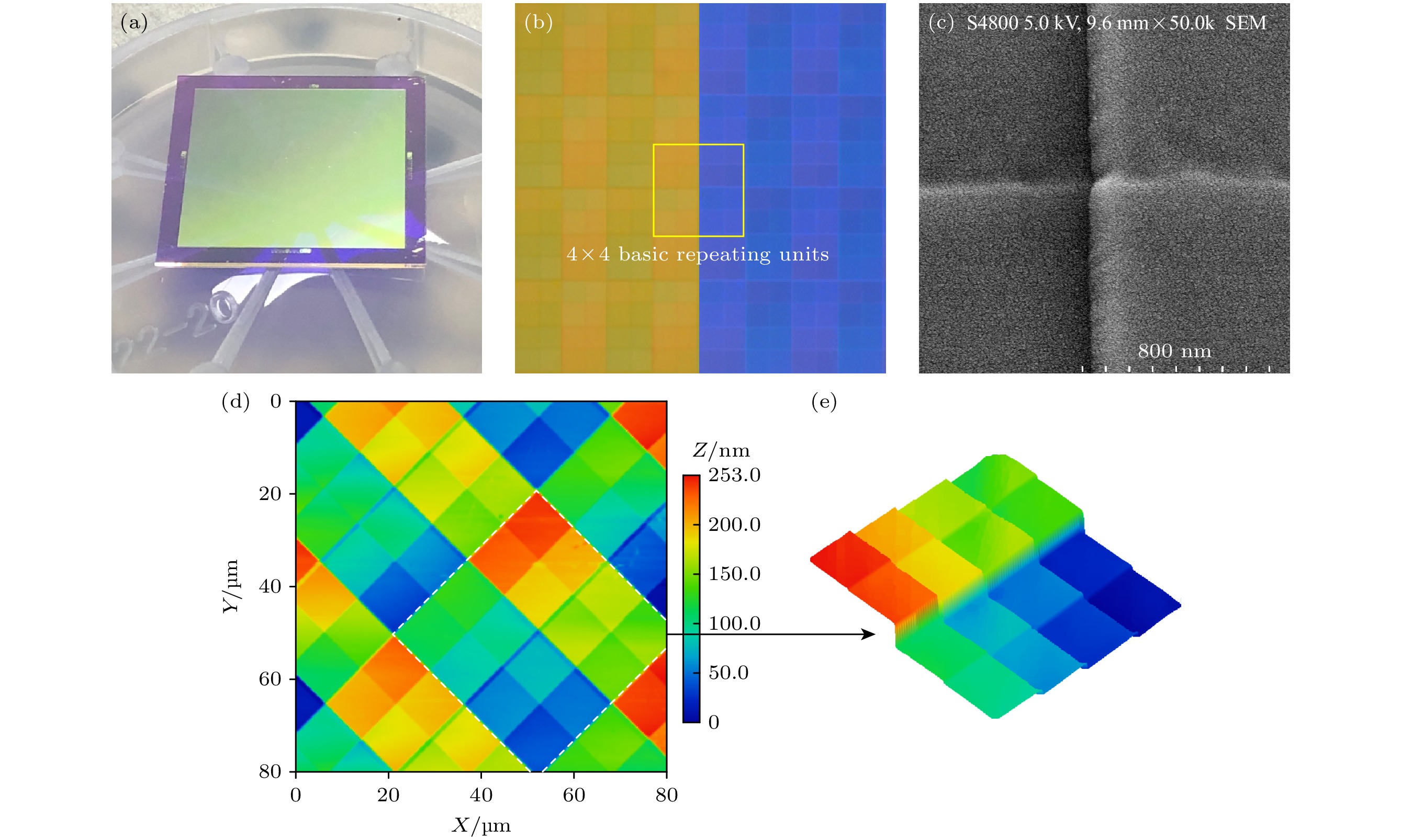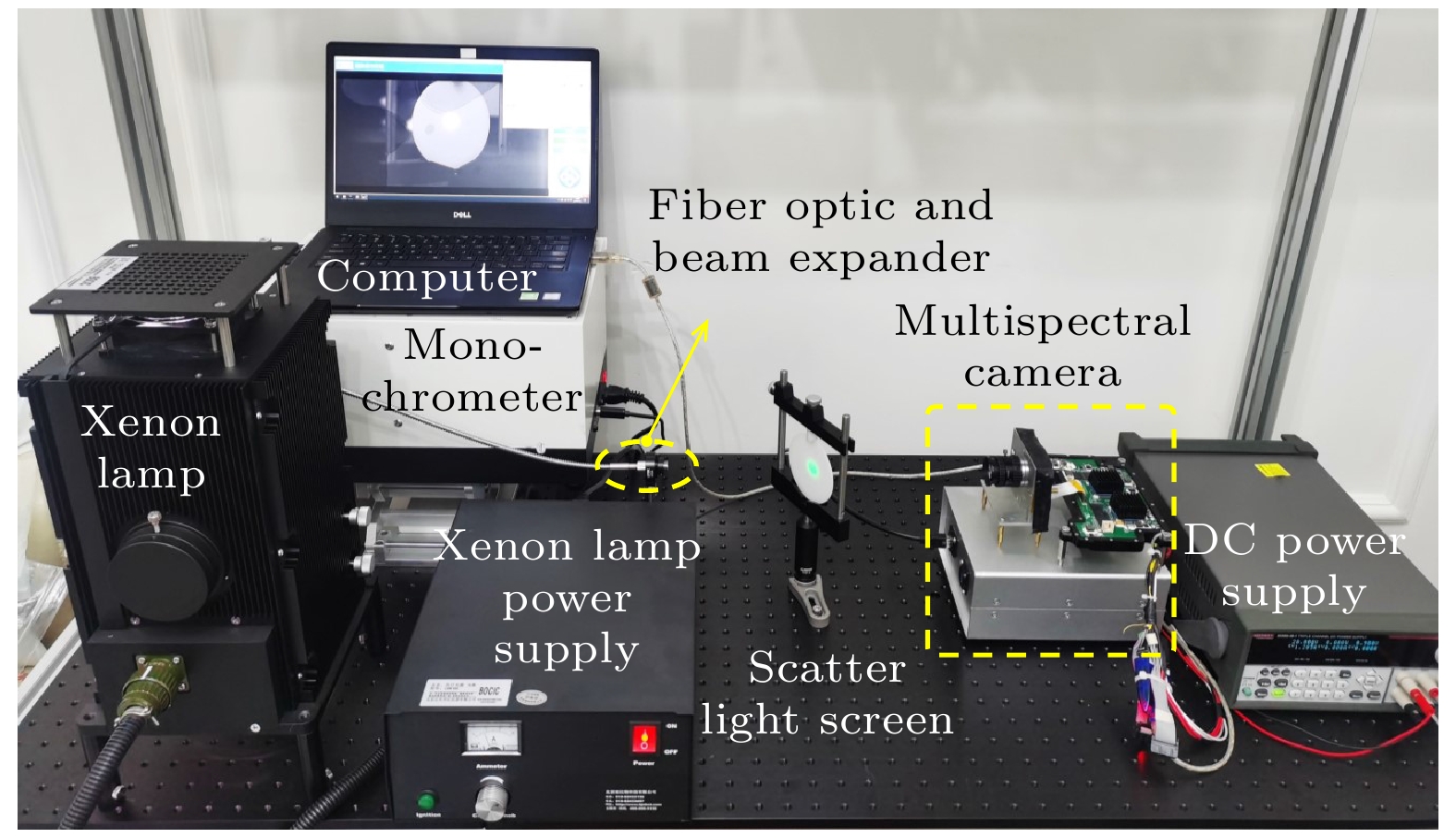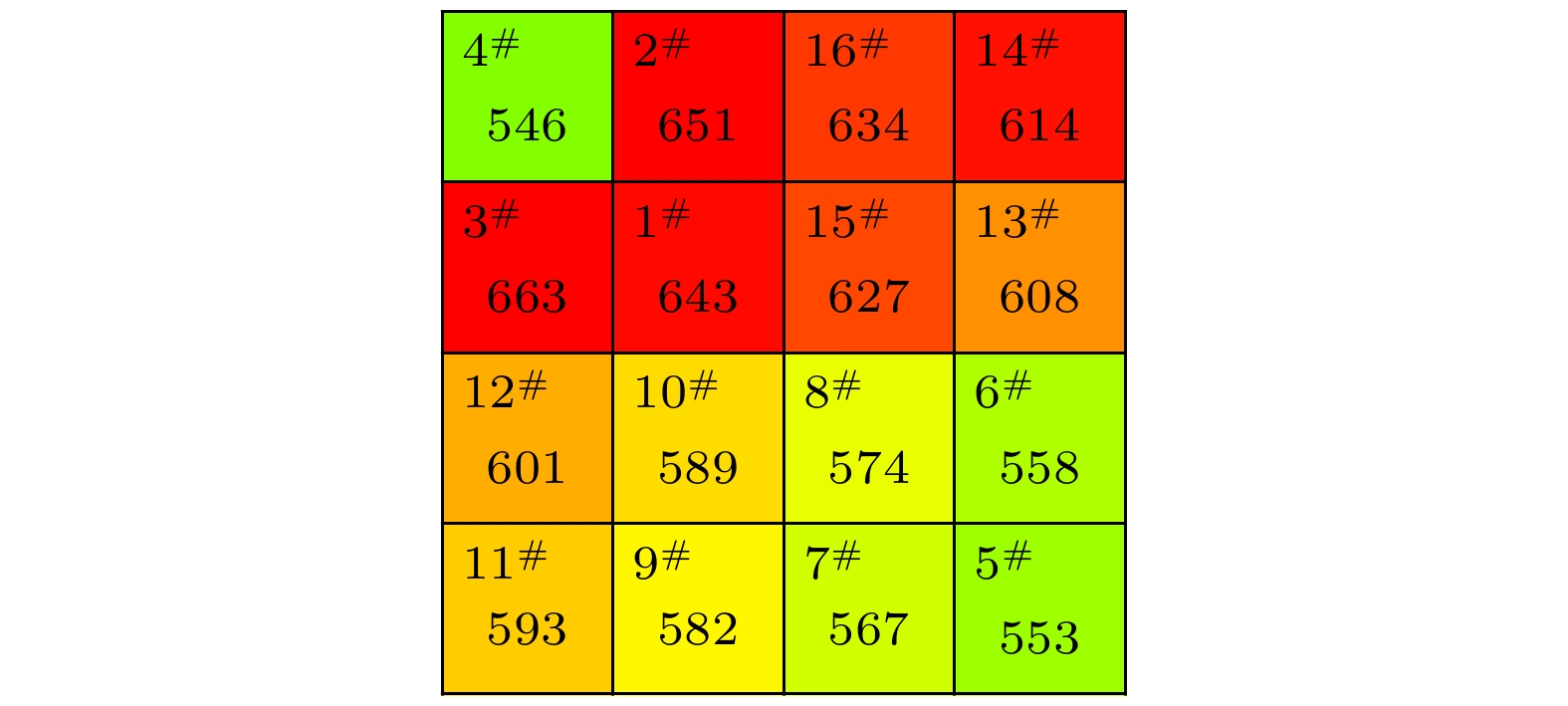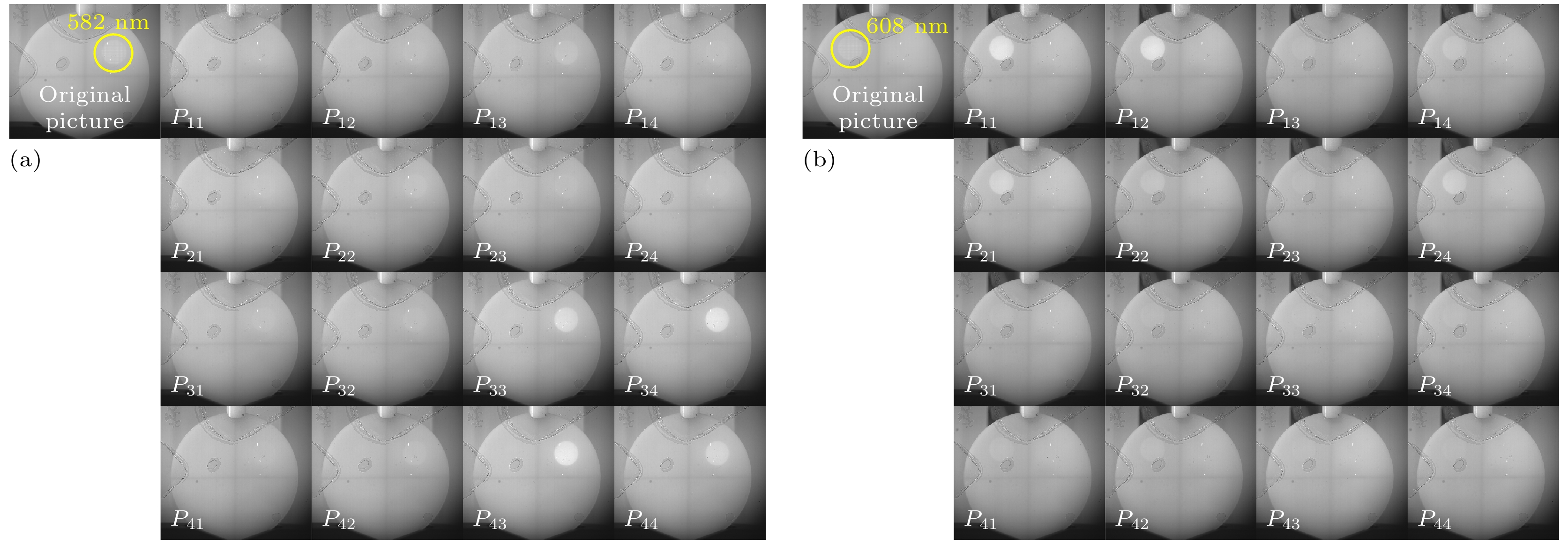-
通过将窄带法布里-珀罗微腔阵列与可见光探测器焦平面阵列粘贴集成, 展示了一种微小紧凑型多光谱成像探测器. 通过四次分形组合蚀刻工艺, 先在石英基底上获得了以4×4为基本重复单元、共计2048像素×2048像素的微腔滤光阵列; 再与探测器芯片贴合后形成了微小型多光谱成像探测器. 微区光谱检测表明, 微腔阵列样品的响应光谱峰值在520—680 nm之间变化, 半峰处的全宽小于10 nm, 透过率约70%. 可调谐波长单色光合作光源检测表明, 该多光谱成像探测器具有16个不同的窄带响应谱; 利用光谱通道能清晰分辨目标特征光谱; 通过光谱通道图像相减, 能有效消除视野中背景, 提高目标对比度. 它有望应用于皮肤表面观测等辅助诊断, 以及逆光条件下目标观测的高动态范围成像等.
By designing and fabricating a narrow-band Fabry-Perot multi-beam interference spectroscopic microcavity array, and integrating it with a visible light detector focal plane array, we demonstrate a small compact multispectral imaging detector. The micro-cavity filter array with 4×4 basic repeating units and a total of 2048×2048 pixels is obtained on a quartz substrate by the four-fractal combination lithograph-etching process. Then the micro miniatured multispectral imaging detector is formed by fitting with the detector chip. The depth and precision of the etching will determine the distribution and offset of the central wavelength of the narrowband spectral channel respectively. The results show that the etching rate of reactive ion is (3.6 ± 0.2) Å/s, and the process is stable and controllable. Due to the different etching depths, the basic repeating unit forms 16 different levels of steps, and the process achieves the design expectation well. The results are obtained as follows: the response spectrum peak of the microcavity array sample varies from 520 to 680 nm, the free spectrum range is 160 nm, the full width at the half-peak is less than 10 nm, the transmittance is about 70%, the relative half-width of the transmittance peak at 590 nm is 1.19%, and the waveform coefficient is 2.78. A 16-channel multispectral camera is constructed by using the optical micro-precision assembly device to realize the precise alignment and the fitting of the micro-cavity filter array and the image sensor. Xenon lamp and monochromator are used as tunable wavelength monochromatic cooperative light source to detect the effect of 16-channel snapshot multispectral imaging on a pixel scale. The results show that the multispectral imaging detector has 16 different narrow-band response spectra. The characteristic spectrum of the target can be clearly distinguished by spectral channel. When imaging the target with known spectral characteristics, for a certain frame of multi-spectral image, selecting a suitable spectral channel can eliminate the background in the field of view through image subtraction and improve the contrast of the target. In the dark room condition, we take the LED light source with center wavelength varying in a range between 528 and 589 nm as the target (the wavelength coincides with the working wavelength of the spectral channel), and effectively suppress the background through the spectral differential intensity subtraction, which can improve the accuracy and sensitivity of the target capture. The 16-channel snapshot multi-spectral imaging detector based on integrated Fabry-Perot microcavity array has the advantages of small size, high integration and strong environmental adaptability, and is expected to play a role in realizing the real-time detection of weak moving targets, auxiliary diagnosis of skin surface observation, and high dynamic range imaging of target observation under backlight conditions. -
Keywords:
- microcavity /
- snapshot /
- multi spectral imaging /
- detector
[1] Janssen P J C 1869 C. R. Acad. Sci. 68 93
[2] Fabry C, Pérot A 1897 Ann. Chim. Phys. 12 459
[3] Hagen N, Kudenov M W 2013 Opt. Eng. 52 090901
 Google Scholar
Google Scholar
[4] Williams C, Gordon G S D, Wilkinson T D, Bohndiek S E 2019 ACS Photonics 6 3132
 Google Scholar
Google Scholar
[5] 周奎, 单政, 张倩, 王谢君, 周健, 邓宸伟, 虞益挺 2022 光学学报 42 080000
 Google Scholar
Google Scholar
Zhou K, Shan Z, Zhang Q, Wang X J, Zhou J, Deng C W, Yu Y T 2022 Acta Opt. Sin. 42 080000
 Google Scholar
Google Scholar
[6] Wang S W, Li M, Xia C S, Wang H Q, Chen X S, Lu W 2007 Appl. Phys. B 88 281
 Google Scholar
Google Scholar
[7] 王绪权, 黄松垒, 于月华, 叶捷敏, 邵秀梅, 方家熊 2018 光子学报 47 530001
 Google Scholar
Google Scholar
Wang X Q, Huang S L, Yu Y H, Ye J M, Shao X M, Fang J X 2018 Acta Photonica Sin. 47 530001
 Google Scholar
Google Scholar
[8] Xuan Z Y, Liu Q Q, Cui Z Z, Huang S L, Yang B, Li C L, Wang S W, Lu W 2022 Chin. Opt. Lett. 20 061302
 Google Scholar
Google Scholar
[9] Yin Z Q, Liu Q Q, Guan X Y, Xie M B, Lu W, Wang S W 2023 Opt. Lett. 48 3371
 Google Scholar
Google Scholar
[10] Xuan Z Y, Wang Z, Liu Q Q, Huang S L, Yang B, Yang L Y, Yin Z Q, Xie M B, Li C L, Yu J Y, Wang S W, Lu W 2022 Adv. Opt. Mater. 10 2200284
 Google Scholar
Google Scholar
[11] Liu Q Q, Xuan Z Y, Wang Z, Zhao X C, Yin Z Q, Li C L, Chen G, Wang S W, Lu W 2022 Opt. Lett. 47 2923
 Google Scholar
Google Scholar
[12] Liu Q Q, Li C L, Xie M B, Wang S W, Yang S M, Zuo Y, Zhao J, Xuan Z Y, Zhu Y Y, Li Z F, Wu Y Q, Lu W 2023 ACS Photonics 10 125
 Google Scholar
Google Scholar
[13] Li C L, Liu Q Q, Zhu Y Y, Zhao X C, Yang S M, Li Z F, Wang S W, Shen X C 2023 Nanoscale 15 11466
 Google Scholar
Google Scholar
[14] 肖树林, 胡长虹, 高路尧 2021 中国科技成果 23 26
 Google Scholar
Google Scholar
Xiao S L, Hu C H, Gao L Y 2021 China Achieve. Sci. Technol. 23 26
 Google Scholar
Google Scholar
[15] Kutteruf Mary R, Yetzbacher Michael K, Deprenger Michael J, Novak K M, Miller C A, Kanaev A, Henry D J, Lange D A, VonBerg D L, Rajan S R, Walls T J, Young D L 2014 Proc. SPIE 9076 90760M
 Google Scholar
Google Scholar
[16] Geelen B, Blanch C, Gonzalez P, Tack N, Lambrechts A 2015 Proc. SPIE 9374 937414
 Google Scholar
Google Scholar
[17] Zhang H, Cai Y, Chen Z L, Xie X L, Chang S L, Fang J Y 2020 Proc. SPIE 11567 115672P
 Google Scholar
Google Scholar
[18] Xiao G Y, Zhang H, Xie X L, Chang S L, Fang J Y 2021 Proc. SPIE 11763 117631Q
 Google Scholar
Google Scholar
[19] Thomas G 2021 Opt. Lett. 46 5926
 Google Scholar
Google Scholar
[20] 季家镕 2007 高等光学教程 (北京: 科学出版社) 第188页
Ji J R 2007 Advanced Optics Tutorial (Beijing: Science Press) p188
-
图 1 16通道快照式多光谱FP微腔阵列的制作工艺 (a) 底部分布式布拉格反射器(distributed Bragg reflector, DBR)和空腔层沉积在石英基底上; (b) 通过UV光刻和反应离子刻蚀组合工艺处理空腔层; (c) 顶部DBR沉积在处理过的空腔层上, 并形成具有4×4个不同FP腔厚度的微腔阵列
Fig. 1. Fabrication process of a 16-channel snapshot type multispectral Fabry Perot microcavity array: (a) Bottom distributed Bragg reflector (DBR) and cavity layer are deposited on a quartz substrate; (b) cavity layer is processed by a combined process of UV photolithography and reactive ion etching; (c) top DBR is deposited on the treated cavity layer and formed with 4 × 4 microcavity arrays with different FP cavity thicknesses.
图 2 (a) 窄带膜系透射峰位置随FP腔厚度发生改变(∆h表示FP腔厚度的改变量); (b) 峰位改变量∆λ随厚度改变∆h的关系(红色直线为拟合结果)
Fig. 2. (a) Transmission peak position of the narrowband film system changes with the thickness of the FP cavity (∆h represents the amount of change in the thickness of the FP cavity); (b) relationship between peak position change ∆λ and thickness change ∆h (Red line represents the fitting result).
图 3 (a) 依次使用A, B, C, D掩膜(以8×8阵列为例)对FP腔进行四步反应离子刻蚀的示意图; (b)—(e) 顺序进行的四步反应离子刻蚀的相对深度(颜色表示刻蚀区域, 数字表示台阶的相对高度)
Fig. 3. (a) Using masks A, B, C, and D in sequence (with 8 × 8 array) schematic diagram of four step reactive-ion etching of FP cavity; (b)–(e) the relative depth of four steps of Reactive-ion etching in sequence (Color indicates the etching area, and number indicates the elevation of the steps).
图 6 微腔阵列样品 (a) 实物照片; (b) 光学显微照片(左半部分为正片, 右半部分为负片); (c) 扫描电子显微图像; (d), (e) 原子力显微镜形貌图及局部放大的4×4重复单元的阶梯状三维形貌(横轴和纵轴是空间坐标; 颜色条表示AFM扫描的相对高度)
Fig. 6. Microcavity array sample: (a) Physical photos; (b) optical micrographs (positive in the left half and negative in the right half); (c) scanning electron microscopy image of the Fabry Perot microcavity array sample; (d), (e) atomic force microscope morphology and step like three-dimensional morphology of locally enlarged 4×4 repeating units (Horizontal and vertical axes are spatial coordinates; the color bar indicates the relative height of the AFM scan).
图 7 微腔阵列样品(波长范围是520—680 nm)的(a)光谱通道中心波长设计值(虚线)与微区透射谱测量曲线(实线); (b)光谱通道中心波长相对设计值的偏离(以中心波长设计值的1%设置error bar); (c) 单个透射峰特性
Fig. 7. (a) Design value of spectral channel center wavelength (dashed line) and measurement curve of micro region transmission spectrum (solid line) of the microcavity array sample (wavelength range 520–680 nm); (b) deviation of the center wavelength of the multispectral channel from the design value (set as error bar at 1% of the center wavelength design value); (c) single transmission peak characteristics.
图 10 (a)—(p) 分别以553, 558, 567, 574, 582, 588, 593, 601, 608, 614, 627, 634, 643, 651, 663和546 nm单色光入射时, 某个4×4重复单元的像素级灰度响应结果
Fig. 10. (a)–(p) Pixel level grayscale response results of a 4 × 4 repeating unit when incident with monochromatic light at 553, 558, 567, 574, 582, 588, 593, 601, 608, 614, 627, 634, 643, 651, 663, and 546 nm, respectively.
表 1 沿A方向测得的高差
Table 1. Measured height difference along direction A.
Item Height difference/nm Etching time/s Etching rate/(Å·s–1) 1 2 3 4 5 6 7 8 Average ∆h1 9.1 9.5 9.2 10.3 9.2 8.9 9.7 9.4 9.41 28 3.36 Δh2 107.2 107.1 107.3 107.5 106.0 107.3 107.0 108.6 107.25 300 3.58 Δh3 113.5 113.0 116.2 123.6 112.0 115.0 113.3 119.3 115.74 328 3.53 表 2 沿B方向测得的高差
Table 2. Measured height difference along direction B.
Item Height difference/nm Etching time/s Etching rate/(Å·s–1) 1 2 3 4 5 6 7 8 Average ∆h1 24.7 23.5 25.0 24.3 24.5 24.3 26.0 24.4 24.59 70 3.51 Δh2 55.5 54.1 57.2 58.0 57.0 56.7 56.8 56.5 56.48 150 3.77 Δh3 76.5 76.5 72.0 73.5 72.6 78.3 77.3 78.1 75.60 220 3.44 -
[1] Janssen P J C 1869 C. R. Acad. Sci. 68 93
[2] Fabry C, Pérot A 1897 Ann. Chim. Phys. 12 459
[3] Hagen N, Kudenov M W 2013 Opt. Eng. 52 090901
 Google Scholar
Google Scholar
[4] Williams C, Gordon G S D, Wilkinson T D, Bohndiek S E 2019 ACS Photonics 6 3132
 Google Scholar
Google Scholar
[5] 周奎, 单政, 张倩, 王谢君, 周健, 邓宸伟, 虞益挺 2022 光学学报 42 080000
 Google Scholar
Google Scholar
Zhou K, Shan Z, Zhang Q, Wang X J, Zhou J, Deng C W, Yu Y T 2022 Acta Opt. Sin. 42 080000
 Google Scholar
Google Scholar
[6] Wang S W, Li M, Xia C S, Wang H Q, Chen X S, Lu W 2007 Appl. Phys. B 88 281
 Google Scholar
Google Scholar
[7] 王绪权, 黄松垒, 于月华, 叶捷敏, 邵秀梅, 方家熊 2018 光子学报 47 530001
 Google Scholar
Google Scholar
Wang X Q, Huang S L, Yu Y H, Ye J M, Shao X M, Fang J X 2018 Acta Photonica Sin. 47 530001
 Google Scholar
Google Scholar
[8] Xuan Z Y, Liu Q Q, Cui Z Z, Huang S L, Yang B, Li C L, Wang S W, Lu W 2022 Chin. Opt. Lett. 20 061302
 Google Scholar
Google Scholar
[9] Yin Z Q, Liu Q Q, Guan X Y, Xie M B, Lu W, Wang S W 2023 Opt. Lett. 48 3371
 Google Scholar
Google Scholar
[10] Xuan Z Y, Wang Z, Liu Q Q, Huang S L, Yang B, Yang L Y, Yin Z Q, Xie M B, Li C L, Yu J Y, Wang S W, Lu W 2022 Adv. Opt. Mater. 10 2200284
 Google Scholar
Google Scholar
[11] Liu Q Q, Xuan Z Y, Wang Z, Zhao X C, Yin Z Q, Li C L, Chen G, Wang S W, Lu W 2022 Opt. Lett. 47 2923
 Google Scholar
Google Scholar
[12] Liu Q Q, Li C L, Xie M B, Wang S W, Yang S M, Zuo Y, Zhao J, Xuan Z Y, Zhu Y Y, Li Z F, Wu Y Q, Lu W 2023 ACS Photonics 10 125
 Google Scholar
Google Scholar
[13] Li C L, Liu Q Q, Zhu Y Y, Zhao X C, Yang S M, Li Z F, Wang S W, Shen X C 2023 Nanoscale 15 11466
 Google Scholar
Google Scholar
[14] 肖树林, 胡长虹, 高路尧 2021 中国科技成果 23 26
 Google Scholar
Google Scholar
Xiao S L, Hu C H, Gao L Y 2021 China Achieve. Sci. Technol. 23 26
 Google Scholar
Google Scholar
[15] Kutteruf Mary R, Yetzbacher Michael K, Deprenger Michael J, Novak K M, Miller C A, Kanaev A, Henry D J, Lange D A, VonBerg D L, Rajan S R, Walls T J, Young D L 2014 Proc. SPIE 9076 90760M
 Google Scholar
Google Scholar
[16] Geelen B, Blanch C, Gonzalez P, Tack N, Lambrechts A 2015 Proc. SPIE 9374 937414
 Google Scholar
Google Scholar
[17] Zhang H, Cai Y, Chen Z L, Xie X L, Chang S L, Fang J Y 2020 Proc. SPIE 11567 115672P
 Google Scholar
Google Scholar
[18] Xiao G Y, Zhang H, Xie X L, Chang S L, Fang J Y 2021 Proc. SPIE 11763 117631Q
 Google Scholar
Google Scholar
[19] Thomas G 2021 Opt. Lett. 46 5926
 Google Scholar
Google Scholar
[20] 季家镕 2007 高等光学教程 (北京: 科学出版社) 第188页
Ji J R 2007 Advanced Optics Tutorial (Beijing: Science Press) p188
计量
- 文章访问数: 6756
- PDF下载量: 188
- 被引次数: 0













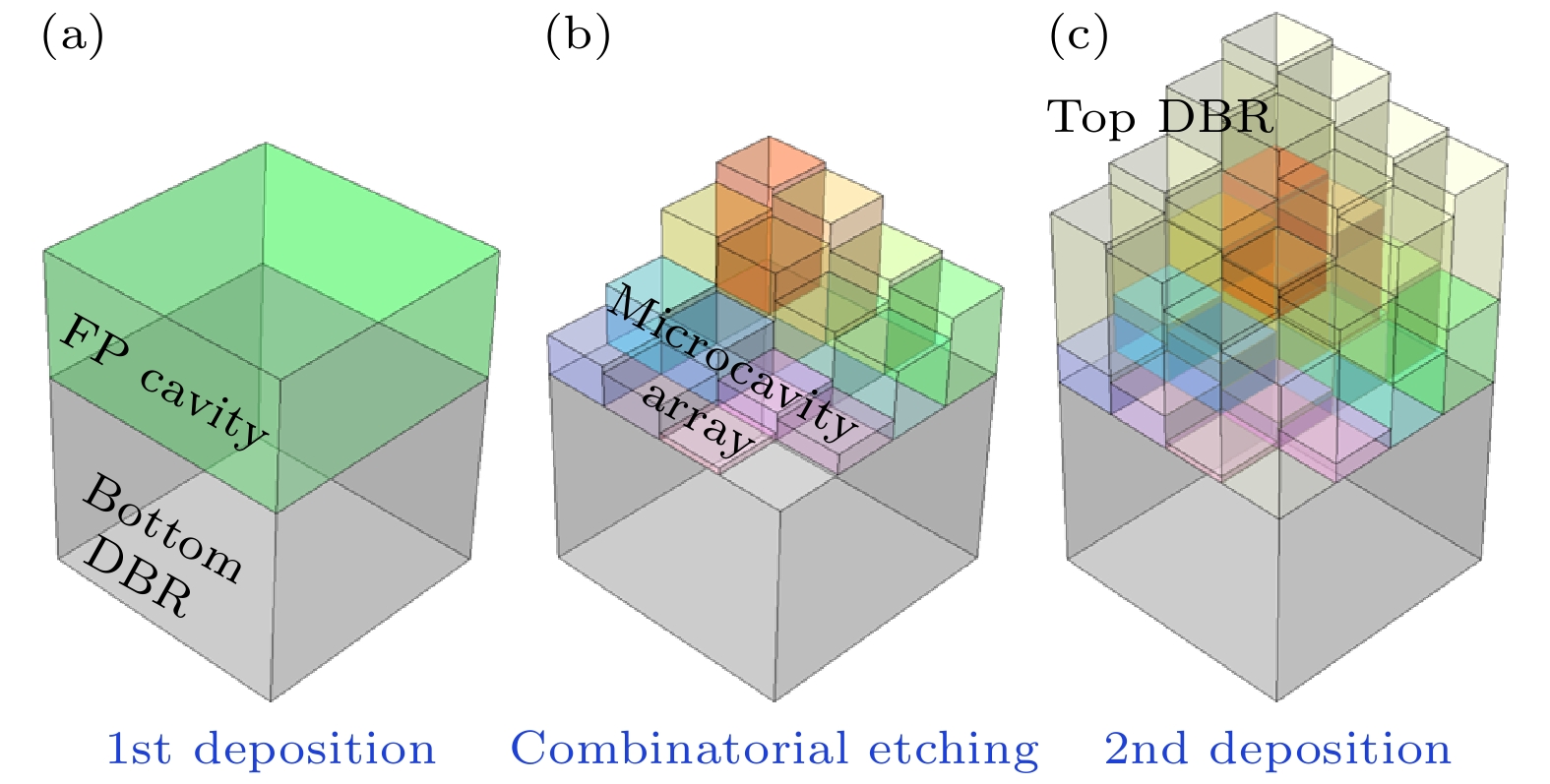
 下载:
下载:

